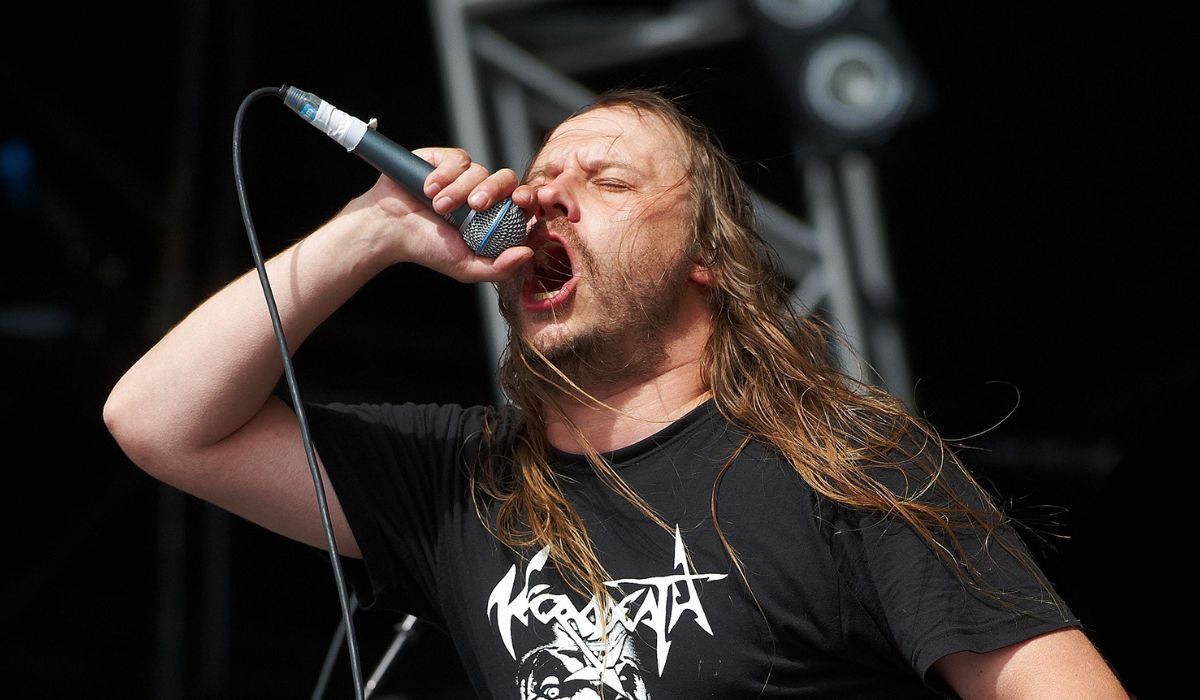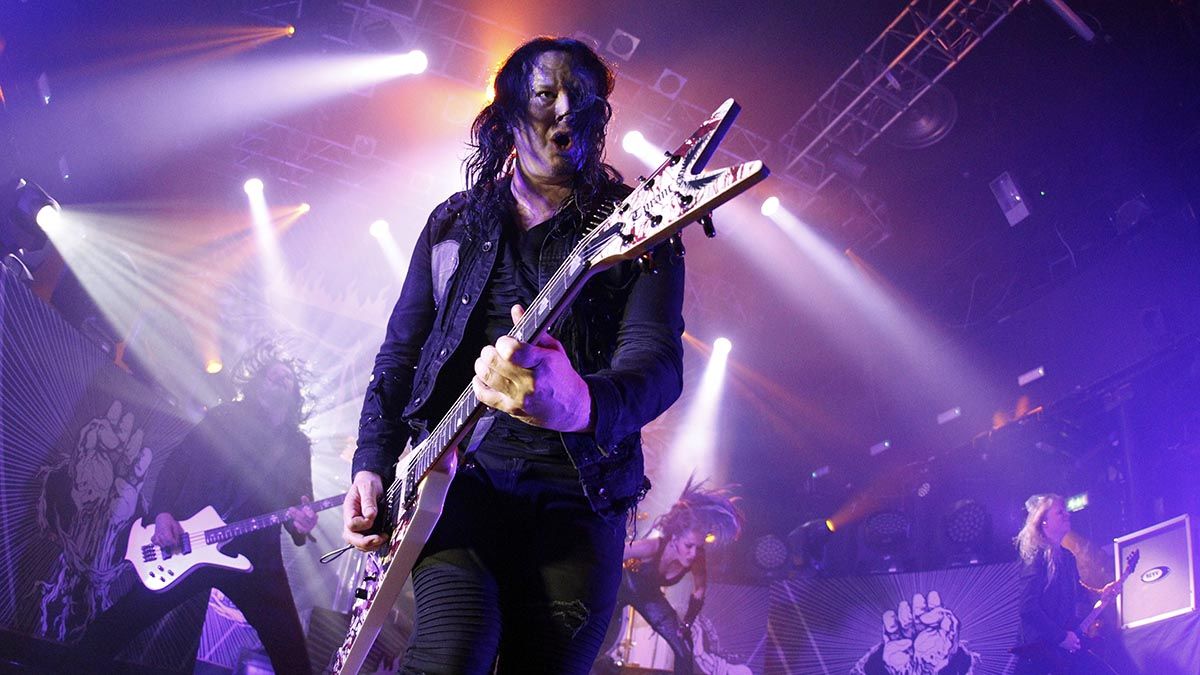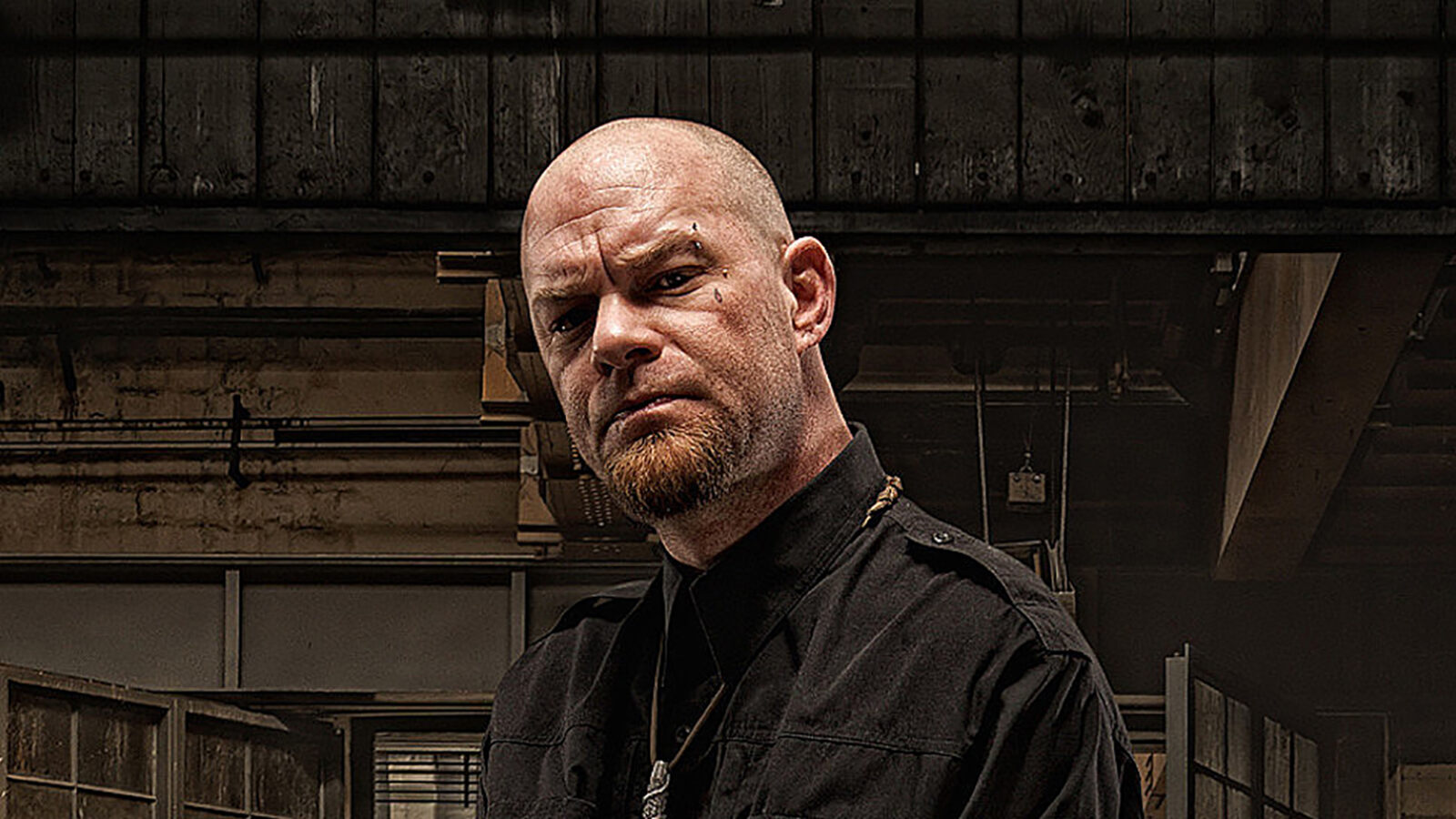Home>Instruments>Vocalist>How To Be A Death Metal Vocalist


Vocalist
How To Be A Death Metal Vocalist
Published: January 23, 2024
Learn the secrets of becoming a death metal vocalist and unleash your vocal prowess. Discover the essential techniques and training needed to excel as a vocalist in the death metal genre.
(Many of the links in this article redirect to a specific reviewed product. Your purchase of these products through affiliate links helps to generate commission for AudioLover.com, at no extra cost. Learn more)
Table of Contents
- Introduction
- Finding Your Vocal Style
- Developing Vocal Power
- Mastering Screaming Techniques
- Controlling Sustain and Vibrato
- Creating Distinctive Growls and Grunts
- Breathing Techniques for Death Metal Vocalists
- Proper Mic Technique
- Vocal Health and Maintenance
- Using Vocal Effects and Distortion
- Performance Tips for Death Metal Vocalists
- Conclusion
Introduction
Welcome to the world of death metal vocals, where guttural growls, blistering screams, and ominous grunts reign supreme. Being a death metal vocalist is not for the faint of heart, but for those passionate about unleashing their raw emotions through extreme vocalization, it can be an exhilarating journey.
Death metal vocals are a unique form of expression that requires a combination of technique, control, and imagination. Whether you’re an aspiring vocalist looking to explore this genre or a seasoned performer seeking to refine your skills, this comprehensive guide will walk you through the essentials of becoming a death metal powerhouse.
In this article, we’ll cover everything from finding your vocal style to mastering screaming techniques, controlling sustain and vibrato, creating distinctive growls and grunts, and even maintaining vocal health. We’ll also delve into the proper use of microphones, vocal effects, and performance tips that will help you deliver a mesmerizing live performance.
But first, it’s essential to understand that death metal vocals are a diverse art form with a wide range of subgenres and vocal styles. From low guttural growls to high-pitched screams, each style brings its own character and intensity to the music.
Whether you resonate with the demonic lows of a guttural style like George “Corpsegrinder” Fisher from Cannibal Corpse or the piercing highs of a shrieking style like Dani Filth from Cradle of Filth, finding your own unique vocal style is paramount. It’s crucial to experiment, listen to different vocalists, and allow your own voice to shape and evolve.
So, if you’re ready to dive into the depths of death metal vocalization, let’s embark on this sonic journey together, and unleash the primal power of your voice.
Finding Your Vocal Style
One of the first steps in becoming a death metal vocalist is finding your own unique vocal style. As mentioned earlier, death metal vocals encompass a wide range of techniques and styles, each with its own distinct characteristics. Here are some tips to help you discover your vocal style:
- Listen to a variety of death metal vocalists: Take the time to explore different subgenres of death metal and listen to vocalists from various bands. Pay attention to their techniques, tonal qualities, and the emotions they convey. This exposure will help you identify the vocal styles that resonate with you.
- Experiment with different vocal techniques: Death metal vocals encompass a spectrum of techniques, including growls, low screams, mid-range screams, high shrieks, and more. Spend time experimenting with these techniques, trying to emulate different vocalists. This experimentation will allow you to discover which techniques feel most comfortable and natural for you.
- Embrace your own voice: While it’s important to draw inspiration from vocalists you admire, it’s equally crucial to embrace your unique voice. Don’t try to imitate others completely but focus on developing your own signature style. Emphasize the aspects of your voice that stand out and make you different from other vocalists.
- Push your limits: One of the defining features of death metal vocals is their intensity and aggression. Push yourself to explore the limits of your vocal range and power. Gradually expand your capabilities by practicing and gradually pushing your vocal boundaries.
- Experiment with vocal effects: Vocal effects and distortion can be powerful tools in enhancing your vocal style. Experiment with different types of effects, such as reverb, delay, and distortion, to add a unique character to your vocals. However, remember to use them judiciously and not let them overshadow your natural voice.
Finding your vocal style is a continuous process that evolves as you gain experience and confidence. Don’t be afraid to experiment, make mistakes, and explore new possibilities. Remember, the ultimate goal is to develop a vocal style that reflects your personality and allows you to express yourself authentically in the world of death metal.
Developing Vocal Power
When it comes to death metal vocals, having vocal power is essential to deliver intense and commanding performances. Here are some techniques to help you develop vocal power:
- Proper breathing technique: Proper breathing is the foundation of vocal power. Practice diaphragmatic breathing, where you inhale deeply, allowing your abdomen to expand and contract as you exhale. This technique maximizes your lung capacity and gives you the power to sustain long and powerful screams.
- Strengthen your diaphragm: The diaphragm is a key muscle involved in controlling your vocal strength. Engage in exercises like singing scales or holding long, sustained notes to develop and strengthen your diaphragm muscles. This will improve your breath control and overall vocal power.
- Release tension: Tension in your throat and vocal cords can hinder your vocal power. Practice relaxation exercises and warm-ups to release any tension you may be holding in your neck and jaw. This will allow your voice to flow freely and ensure a more powerful and effortless delivery.
- Resonance and projection: To achieve vocal power, work on resonating your sound in your chest and head cavities. Utilize proper vocal placement techniques to project your sound forward and fill the room. This will give your vocals a commanding presence and enhance their overall power.
- Vocal exercises: Regular vocal exercises are crucial for developing and maintaining vocal power. Focus on exercises that target your vocal range, agility, and control. Incorporate scales, arpeggios, lip trills, and sirens into your practice routine to strengthen your voice and increase your vocal power.
Remember that developing vocal power takes time and consistent practice. Start with shorter durations of intense vocals and gradually increase your stamina. It’s important not to strain or push your voice beyond its limits, as this can lead to vocal damage. Listening to your body and practicing moderation is key.
Additionally, incorporating proper vocal warm-up and cool-down routines into your practice sessions is essential. This helps prepare your voice for the demands of death metal vocals and aids in preventing vocal strain or injury.
By focusing on these techniques and incorporating them into your regular practice routine, you’ll gradually increase your vocal power and be able to deliver the powerful and commanding performances that define the world of death metal vocals.
Mastering Screaming Techniques
Screaming is a fundamental aspect of death metal vocals, delivering the raw aggression and intensity that define the genre. Here are some tips to help you master screaming techniques:
- Warm up your vocals: Before attempting any screaming techniques, it’s crucial to warm up your vocal cords. Start with gentle vocal exercises and gradually increase the intensity. This prepares your voice for the demands of screaming and reduces the risk of strain or injury.
- Understand the different types of screams: Death metal vocals encompass various types of screams, including low growls, mid-range screams, and high shrieks. Familiarize yourself with these different techniques and experiment with each to find which suits your voice and style best.
- Maintain proper vocal technique: While screaming might seem like an aggressive and chaotic vocalization, it’s important to maintain proper vocal technique to prevent vocal damage. Focus on breath support, vocal placement, and controlling your airflow while exerting the necessary power and intensity.
- Experiment with vocal fry and false cords: Vocal fry and false cord techniques are commonly used in death metal vocals to achieve the desired distortion and grit. Practice using these techniques to add depth and texture to your screams. However, be cautious not to strain your voice or push beyond your limits.
- Practice vocal fry exercises: Vocal fry exercises help develop the necessary coordination and control required for screaming. Begin with short bursts of vocal fry and gradually increase the duration. Focus on maintaining a consistent sound and gradually adding power and volume.
- Be mindful of vocal health: Screaming can put significant strain on your vocal cords, so it’s vital to take care of your voice. Stay hydrated, avoid excessive screaming without proper vocal rest, and practice good vocal hygiene. If you experience any discomfort or pain in your vocal cords, seek professional guidance.
Remember, mastering screaming techniques requires time, patience, and consistent practice. Start slowly and gradually build up your endurance and control. Don’t push your voice beyond its limits and always prioritize vocal health.
Additionally, listening to experienced death metal vocalists and studying their techniques can provide valuable insights and inspiration. Analyze their delivery, posture, and overall stage presence to incorporate those elements into your own performances.
With dedication and practice, you can master the art of screaming and unleash a visceral and captivating vocal performance as a death metal vocalist.
Controlling Sustain and Vibrato
In death metal vocals, having control over sustain and vibrato is essential for adding depth and character to your performances. Here are some techniques to help you control sustain and vibrato:
- Breath support: Proper breath support is key to controlling sustain and vibrato. Ensure you have a solid foundation of diaphragmatic breathing to provide the necessary airflow for sustained notes. Practice exercises that focus on breath control to improve your sustaining abilities.
- Focus on pitch accuracy: Before incorporating vibrato, it’s crucial to have a solid sense of pitch accuracy. Work on hitting and sustaining specific pitches without wavering. This foundation will allow you to apply vibrato more effectively and with better control.
- Experiment with different vibrato styles: Vibrato is the fluctuation of pitch that adds richness and texture to sustained notes. Experiment with different vibrato styles, such as wide, narrow, or pulsating, to find the one that complements your voice and style best. Play around with the speed and depth of your vibrato to achieve different effects.
- Control tension in your throat: Tension in your throat can affect your ability to sustain notes and control vibrato. Practice relaxation exercises to release any tension in your throat and neck muscles. This will allow for smoother and more controlled sustain and vibrato.
- Listen to vocalists for inspiration: Study the techniques of experienced death metal vocalists who excel in sustain and vibrato control. Listen to how they manipulate their vocal tone and incorporate sustain and vibrato into their performances. This will provide valuable inspiration and insights for your own practice.
- Record and analyze your performances: Record your vocals and take the time to analyze your sustained notes and vibrato. Listen for any inconsistencies or areas that need improvement. In doing so, you can focus on specific aspects to enhance your control and make necessary adjustments.
Remember, developing control over sustain and vibrato requires patience, practice, and a keen ear. It’s important to find the right balance between adding depth and character to your vocals while maintaining control and pitch accuracy.
As you continue to practice and refine your technique, you’ll gain a better understanding of how to manipulate sustain and vibrato to elevate your performances. Embrace the unique qualities of your voice while working on enhancing sustain and incorporating vibrato in a way that complements your style as a death metal vocalist.
Creating Distinctive Growls and Grunts
Guttural growls and deep grunts are signature vocal techniques in death metal, adding a menacing and brutal element to the music. Here are some tips to help you create distinctive growls and grunts:
- Relax your throat, jaw, and tongue: Creating guttural sounds requires a relaxed throat, jaw, and tongue. Tension in these areas can inhibit your ability to produce deep growls. Practice relaxation exercises and focus on keeping your mouth open and loose while vocalizing.
- Engage your diaphragm: To create powerful and sustained growls, engage your diaphragm muscles. This helps to push air from your lungs and create a forceful sound. Practice diaphragmatic breathing and experiment with different levels of breath pressure to achieve varying degrees of intensity in your growls.
- Explore vocal fry and false cord techniques: Vocal fry and false cord techniques are commonly used in creating low growls and grunts. Experiment with these techniques to achieve the desired deep and raspy tone. Be mindful not to strain your voice and gradually build up your endurance and control.
- Experiment with mouth and tongue positions: The positioning of your mouth and tongue can greatly influence the quality of your growls and grunts. Explore different mouth shapes and tongue placements to find the resonance points that produce the distinctive tones you’re aiming for.
- Add vocal distortion: Utilize vocal distortion techniques to add texture and character to your growls and grunts. Experiment with adding slight grit, rasp, or grittiness to your voice to create a unique sound. Be careful not to overdo it, as excessive strain can lead to vocal damage.
- Listen to and study experienced vocalists: Study the techniques of renowned death metal vocalists who excel in creating distinctive growls and grunts. Listen to their recordings, analyze their vocal delivery, and pay attention to the nuances in their vocal techniques. This can provide valuable insights and inspiration for developing your own unique style.
Remember, creating distinctive growls and grunts takes time and experimentation. Be patient with yourself and give yourself the freedom to explore different techniques and find what works best for you. It’s essential to strike a balance between intensity and control to maintain vocal health and longevity.
With practice and dedication, you can develop a signature growl or grunt that sets you apart as a death metal vocalist, adding your own unique voice to the brutal landscape of the genre.
Breathing Techniques for Death Metal Vocalists
Breathing is a fundamental aspect of vocal performance, and for death metal vocalists, proper breathing techniques are crucial to support the intense demands of their vocal style. Here are some breathing techniques specifically tailored for death metal vocalists:
- Diaphragmatic breathing: Diaphragmatic breathing, also known as belly breathing, is a technique that utilizes the diaphragm muscle to maximize breath control and lung capacity. Practice deep inhalations, allowing your abdomen to expand, and exhale fully, contracting your abdomen. This technique provides a solid foundation for powerful vocal delivery.
- Controlled breath support: Death metal vocals require sustained and powerful vocalization. Learning to control your breath support is essential for executing long and intense phrases. Focus on engaging your diaphragm, maintaining a steady airflow, and avoiding breathy or weak vocal delivery.
- Quick recovery breaths: Death metal vocals often involve rapid, intense passages that require quick recovery between phrases. Practice taking quick, shallow recovery breaths through your nose to replenish air efficiently. This allows you to maintain continuity in your performance without compromising power or precision.
- Dynamic breath control: Death metal vocalists need to navigate between soft, low passages and explosive, high-energy moments. Mastering dynamic breath control allows you to easily transition between these extremes while maintaining consistent control and intensity. Practice controlling your airflow to match the dynamics of the song.
- Breath management between phrases: Death metal performances can be physically demanding, and breath management between phrases is crucial for vocal stamina. Learn to take efficient recovery breaths without interrupting the flow of the music. Use pauses strategically to create anticipation and add dynamics to your performance.
- Practice breath exercises: Incorporate breath exercises into your vocal warm-up routine to strengthen your breath control and lung capacity. Exercises like lip trills, sirens, and sustained notes on different vowel sounds help expand your breath capacity and improve overall vocal technique.
Remember, mastering breathing techniques is an ongoing process that requires regular practice and mindfulness. Consistency and focus on proper technique will help you develop the necessary endurance, control, and power to deliver impressive death metal vocal performances.
Additionally, take care of your overall physical health by maintaining good posture, staying hydrated, and avoiding habits that can affect your respiratory system negatively, such as smoking or excessive throat clearing. These factors contribute to the overall health and functionality of your voice.
By incorporating these breathing techniques into your vocal practice routine, you’ll be equipped to tackle the challenging vocal demands of death metal with confidence and precision.
Proper Mic Technique
In the world of death metal vocals, mastering proper mic technique is essential for delivering a powerful and captivating performance on stage. Here are some tips to help you hone your mic technique:
- Position the mic correctly: Position the microphone close to your mouth, ideally around one to two inches away. Adjust the angle of the microphone to capture the best sound and minimize feedback. Experiment with different positions to find the optimal balance between capturing your vocals and avoiding unwanted distortion or breath sounds.
- Hold the mic with intent: Grip the microphone with confidence and control. Avoid holding it too tightly, as this can restrict your vocal technique and cause unnecessary tension. Find a comfortable grip that allows you to deliver your vocals effortlessly while maintaining a firm hold on the microphone.
- Control proximity effect: Death metal vocals often make use of the proximity effect, which is the increase in bass response when the microphone is held closer to your mouth. Experiment with different distances to find the right balance. Pulling the mic slightly away during loud passages can help prevent overwhelming low-end frequencies and maintain clarity.
- Work with the microphone’s polar pattern: Microphones have different polar patterns, such as cardioid or supercardioid, which determine the directionality and sensitivity to sound. Understand the polar pattern of your microphone and use it to your advantage. Position yourself in front of the mic to capture the fullness of your vocals without blocking the airflow or distorting the sound.
- Be mindful of stage monitors: When performing on stage, monitor placement can affect your mic technique. Avoid positioning yourself directly in front of loud stage monitors to prevent feedback. Communicate with your sound engineer to ensure an optimal monitor mix that allows you to hear yourself clearly without overpowering your vocal performance.
- Use pop filters and wind protection: Pop filters and windshields are essential tools for death metal vocalists to minimize plosive sounds and protect the microphone from excessive breath or unwanted noises. Invest in a quality pop filter and consider using foam or furry windshields when performing in outdoor or high-wind environments.
In addition to these tips, it’s important to rehearse and incorporate mic technique into your practice sessions. Perform in front of a mirror or record yourself to observe your movements and make necessary adjustments. Seeking feedback from trusted individuals or a vocal coach can also provide valuable insights into refining your mic technique.
Remember, mastering proper mic technique takes time and experience. As you become more accustomed to the stage and microphone, you’ll develop a natural rapport, allowing you to focus on delivering an electrifying performance without distractions.
By employing these mic techniques, you’ll ensure that your death metal vocals are projected powerfully and effectively to captivate audiences and bring your performance to life.
Vocal Health and Maintenance
Maintaining vocal health is crucial for death metal vocalists to sustain their performances and prevent potential damage to their voices. Here are some tips for vocal health and maintenance:
- Stay hydrated: Hydration is vital for keeping your vocal cords lubricated and preventing dryness. Drink plenty of water throughout the day, especially during performances and practice sessions. Avoid excessive caffeine and alcohol consumption, as they can dehydrate your body and vocal cords.
- Practice proper vocal warm-ups and cool-downs: Prior to vocalizing, warm up your voice with gentle exercises to prepare your vocal cords for the demands of death metal vocals. After performing, cool down your voice with gentle humming or sirens. Proper warm-up and cool-down routines help prevent vocal strain and maintain vocal health.
- Avoid vocal abuse: Death metal vocals can be intense, but it’s important to avoid vocal abuse. Avoid screaming excessively outside of performances, as this can strain your vocal cords. Avoid smoking and exposure to secondhand smoke, as they can irritate and damage your vocal cords.
- Monitor vocal fatigue: Pay attention to signs of vocal fatigue, such as hoarseness, soreness, or a weak voice. If you experience these symptoms, give your voice adequate rest and avoid straining or pushing your voice further. Consider consulting with a speech pathologist or vocal coach to assess your vocal technique and address any potential issues.
- Practice good posture and breath support: Maintaining proper posture and engaging in diaphragmatic breathing provide the foundation for healthy vocal production. Stand or sit up straight, with your shoulders relaxed and your head aligned with your spine. This allows for optimal breath support and reduces unnecessary tension in your neck and throat.
- Get sufficient rest: Adequate rest is essential for vocal health. Ensure you’re getting enough sleep to allow your voice to recover and rejuvenate. Fatigue can compromise your vocal performance and increase the risk of vocal strain and injury.
If you experience persistent vocal issues or are unsure about your vocal health, it’s always advisable to seek guidance from a qualified vocal health professional, such as an otolaryngologist or a speech-language pathologist specializing in voice disorders.
Remember, taking care of your voice is a long-term commitment. Consistently practicing good vocal hygiene and incorporating healthy habits into your daily routine will contribute to the longevity and sustainability of your death metal vocal career.
By prioritizing vocal health and implementing these guidelines, you can ensure the endurance and preservation of your voice, delivering powerful and impactful performances for years to come.
Using Vocal Effects and Distortion
In the world of death metal vocals, utilizing vocal effects and distortion can add depth, texture, and intensity to your vocal performance. Here are some tips for using vocal effects and distortion effectively:
- Experiment with different effects: There is a wide range of vocal effects available, such as reverb, delay, chorus, and flanger. Experiment with these effects to find the ones that complement your vocal style and the overall sound of your band. Each effect can create a unique atmosphere and enhance the impact of your vocals.
- Use effects sparingly: While vocal effects can enhance your performance, it’s important to use them sparingly and tastefully. Avoid overwhelming your vocals with excessive effects that detract from the clarity and intelligibility of your lyrics. The goal is to enhance your vocals, not to overshadow them.
- Consider distortion for intensity: Distortion is a popular effect in death metal vocals as it adds a raw and aggressive quality to the voice. Experiment with different types of distortion, such as overdrive or fuzz, to find the one that suits your voice and the desired intensity of your performance. However, be cautious not to strain your voice or compromise vocal health in pursuit of extreme distortion.
- Layer effects for depth: To create a more complex and dynamic vocal sound, consider layering different effects. For example, combining reverb with a touch of delay can create a sense of depth and space in your vocals. Be creative and experiment with different combinations to find the sonic texture that resonates with your personal style.
- Use effects to emphasize certain vocal sections: Employ vocal effects selectively to highlight specific sections of your vocals. Consider using effects to accentuate climactic moments, add emphasis to particular lyrics, or create a sense of transition between different parts of the song. This strategic use of effects can enhance the overall impact and intensity of your performance.
- Experiment with live vs. studio effects: Keep in mind that the effects you use in live performances may differ from those in the studio. Live settings often require more immediate and impactful effects, while you have more control and precision in a studio environment. Adapt your use of effects to suit the context and make adjustments based on audience feedback and your own personal preferences.
Remember, vocal effects and distortion should enhance and complement your vocals rather than compensate for poor technique or lack of vocal intensity. Practice and develop your core vocal skills before integrating effects into your performance.
Working with a sound engineer or producer who specializes in death metal vocals can also be tremendously helpful in selecting and optimizing vocal effects. Their expertise can ensure that your vocals stand out in the mix while maintaining clarity and impact.
By utilizing vocal effects and distortion thoughtfully and purposefully, you can elevate your death metal vocal performance to new heights, adding layers of intensity and creating a captivating sonic experience for your listeners.
Performance Tips for Death Metal Vocalists
Performing as a death metal vocalist is an exhilarating experience that requires not only vocal prowess but also a captivating stage presence. Here are some performance tips to help you deliver a memorable and electrifying show:
- Connect with the music: Death metal is known for its intense and aggressive sound. Before stepping on stage, immerse yourself in the music. Feel the energy and emotions it evokes and let that passion drive your performance. Let the music flow through you and guide your movements and vocal delivery.
- Embrace the role: Death metal vocals often portray a dark and menacing persona. Embrace the role and channel your inner intensity and aggression. Focus on conveying the emotions and themes of the music through your facial expressions, body language, and vocal delivery. Connect with the lyrics and deliver them with conviction and raw energy.
- Engage with the audience: Death metal performances are not just about the music, but also about connecting with the audience. Make eye contact, interact with the crowd, and create a sense of unity and shared experience. The more you engage with the audience, the more they will be drawn into your performance.
- Move with purpose: Death metal vocals are dynamic, and your movements should reflect that. Use your body language to convey the intensity of the music. Incorporate headbanging, aggressive gestures, and commanding stage presence. Move with purpose and conviction, ensuring that your movements enhance the impact of your vocals.
- Utilize stage space: Take advantage of the entire stage area to create a visually captivating performance. Explore different areas of the stage, interact with bandmates, and use props or visual elements that align with the themes of the music. Be mindful of your surroundings and the movements of the other band members to ensure a cohesive and energetic performance.
- Practice breath control: Death metal vocals require stamina and endurance. Practice breath control to maintain consistent power and intensity throughout your performance. Incorporate proper breath support techniques and take strategic breaks between intense passages to recover and recharge.
- Express yourself authentically: Death metal vocals are a form of self-expression. Don’t be afraid to let your true self shine through your performance. Embrace your unique vocal style, unleash your emotions, and deliver a performance that is true to who you are as an artist. Authenticity is key to connecting with your audience and leaving a lasting impression.
Remember, each performance is an opportunity to create a memorable experience for both yourself and the audience. Practice regularly, refine your vocal techniques, and rehearse your stage presence to develop a commanding presence as a death metal vocalist.
Lastly, always prioritize your vocal health and safety. Avoid pushing your voice to the point of strain or injury, and seek guidance from a vocal coach or professional if you have any concerns or questions regarding technique, performance, or vocal health.
By incorporating these performance tips into your repertoire, you’ll become a captivating and electrifying death metal vocalist, leaving a lasting impression on every stage you conquer.
Conclusion
Being a death metal vocalist is a challenging yet rewarding journey that requires a combination of skill, technique, and passion. Throughout this comprehensive guide, we have explored the essential aspects of becoming a formidable death metal vocalist.
From finding your vocal style and developing vocal power to mastering screaming techniques and controlling sustain and vibrato, each step is a crucial building block in your vocal journey. We discussed the importance of proper mic technique, vocal health, and the strategic use of vocal effects and distortion to enhance your performance. Additionally, we explored performance tips to help you create a captivating stage presence and connect with your audience on a visceral level.
Remember, becoming an accomplished death metal vocalist takes time, patience, and dedication. Regular practice, vocal health maintenance, and ongoing self-exploration are key to developing your unique voice and style within the genre.
As you continue on your path as a death metal vocalist, it’s important to always prioritize vocal health, proper technique, and authenticity. Honing your skills, staying true to yourself, and continually pushing the boundaries of your vocal capabilities will set you up for success and growth.
Whether you’re aspiring to enter the world of death metal vocals or looking to refine your existing skills, the knowledge and techniques shared in this guide will serve as valuable tools on your journey. Remember, there is no one-size-fits-all approach to being a death metal vocalist. Embrace your individuality, keep listening to different vocalists for inspiration, and let your voice resonate with the primal power that defines the genre.
Now, armed with this comprehensive guide, it’s time to unleash the beast within you and ignite the stage with your death metal vocal prowess. So go forth, make your mark, and let your voice be heard throughout the realms of metal!











